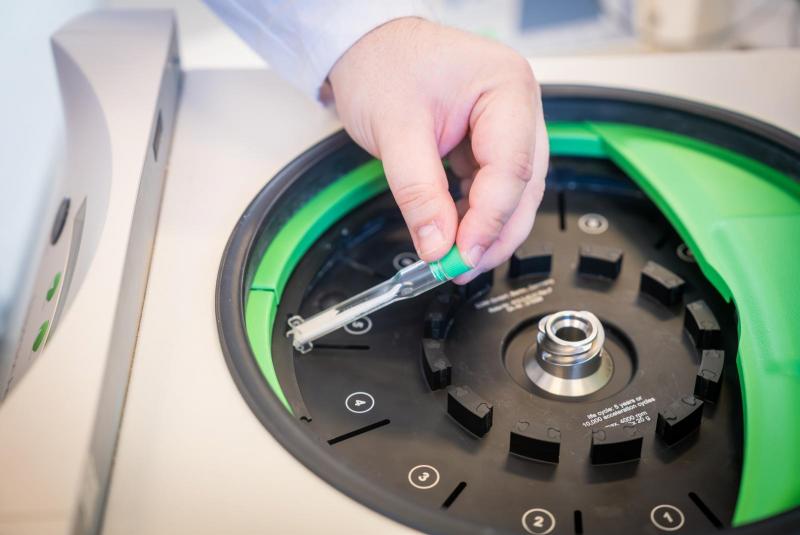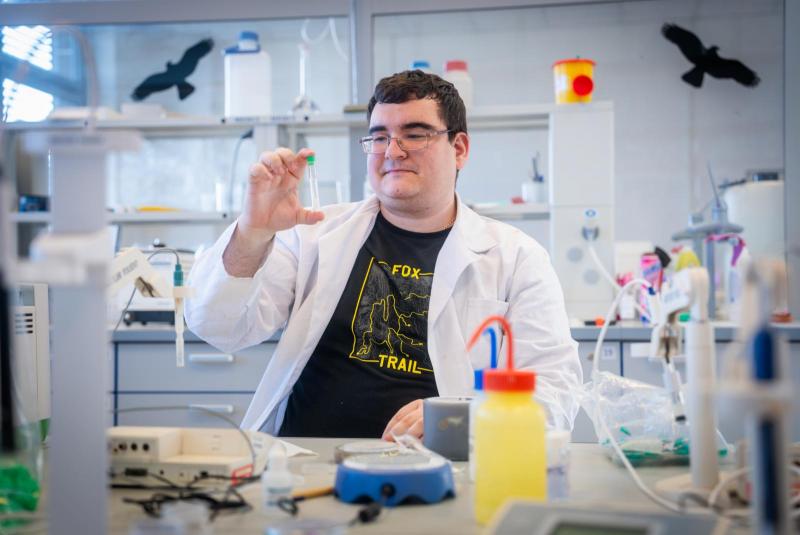PhD student Patrik Sokola on research into photocurable suspensions: I enjoy the wow effect when making new discoveries
What challenges does ceramic materials research bring, and how can innovative approaches help improve their properties? Patrik Sokola, a PhD student at the Institute of Materials Chemistry, FCH BUT, focuses on the study of photocurable ceramic suspensions containing zirconia nanoparticles. He explores their rheology, stability, and potential applications in 3D printing. Together with his supervisor, Petr Ptáček, they developed a new rheological model that enables more accurate predictions of the flow behavior of these materials. For his work, he was nominated for the prestigious Jean-Marie Lehn Prize for Chemistry. In the interview, he shared what fascinates him about research and the practical applications it may bring.

I focus on studying photocurable suspensions with zirconia nanoparticles – I examine their rheology, stability, and particle agglomeration. At the moment, I have optimized the composition of the suspensions and I’m testing them for 3D printing on the faculty’s DLP printer. A common issue is particle sedimentation. How can measurements be accurate when half the particles have already settled to the bottom? Stability was addressed within the context of rheological measurements using concentric cylinders. In DLP printing, suspension stability is examined quite frequently – mostly using more “primitive” methods – by observing sedimentation over time in a graduated cylinder, so-called “by eye”. Thanks to the LUMiSizer centrifuge, we found that our suspensions are highly stable and can remain unchanged for several months.
In addition to a new approach to measuring stability, we also developed a new rheological model, which we compared to existing ones and showed its high accuracy. The long-term goal is to expand the research to paste-like suspensions with both nano- and microparticles, which opens the door for additional applications, especially in ceramic 3D printing.
What do you enjoy most about your work, and what is the biggest challenge?
I enjoy the freedom – my supervisor gives me a free hand with experiments – and the “wow effect” when making new discoveries. And of course, the opportunity to travel. The challenge tends to be the drawn-out bureaucracy and the general underfunding of science.
Was there a moment during your research that particularly surprised or excited you?
When we derived the new model with my supervisor, all the data I had showed a high correlation, and I thought: “This can’t be real.” It also helps that these measurements are relatively quick. I can gather enough data in two or three weeks and evaluate them as I go. When a sample behaves as predicted, it’s very satisfying. And if something is mixed incorrectly or something goes wrong, you can spot it almost immediately.
Another highlight was my internship in Croatia at the University of Zagreb, where we worked on porous ceramics. We started adding waste materials to the ceramics and found that it created huge pores. In the end, we decided to use the material to enhance the properties of porous ceramics and to increase porosity, which turned out to be a great success. I’m currently writing a paper about it for the Nanocon conference in Brno.

So far in my PhD, nothing major – knock on wood. But during my master’s, there was a situation that was more terrifying than funny at the time. The LUMiSizer works by placing cuvettes inside, which are then centrifuged. My suspensions contained epoxy resin, which aggressively corrodes polycarbonate. So when I filled all 12 slots and started the measurement, strange lines appeared on the screen. I thought: “This must be some interesting phenomenon” (laughs). But when we opened the device, we saw the epoxy had completely dissolved the cuvettes, splashed inside, and started leaking into the electronics. That’s when the sweating started (laughs). Two hours of intensive cleaning followed. Fortunately, the electronics survived.
An even older fail was during my first physics lab at university. I was working with an electronic pendulum measuring oscillation periods. I pulled it back, let it go – nothing. First lab ever, stress! The instructor came and found that the pendulum wasn’t plugged in. Then we were supposed to gradually tilt the pendulum up to 90 degrees. I did – and boom. It fell. I was too scared to tell anyone, so I spent an hour and a half manually swinging it and recording the movement. In the end, I managed to “configure” it back and just hoped the next person wouldn’t knock it over right away. I think it’s still there, so I guess I didn’t break it permanently. Hopefully, the statute of limitations has passed (laughs).
What drew you to study chemistry?
Since elementary school, I took part in chemistry olympiads, and a big role was played by an amazing teacher and the beauty of chemistry itself. Already in sixth grade, when we started learning chemistry, I thought: “Wow, this is something you can actually see.” Math is great, but it’s always just on paper. Our teacher wasn’t afraid to ignite or blow something up, which was fascinating for a kid. First you just see something explode and change color, and then you start to ask – why? What’s behind it? You understand some things in high school, some in university, and some still not yet (laughs). Maybe with a PhD, I’ll get there.
I also completed a teaching certification – I enjoy technical education. For example, I help a colleague with his research, which is completely outside my field – I like learning something new, brainstorming, diving into problems.
Why did you choose FCH BUT?
I was choosing between multiple universities in various cities, but this one had the most chemistry-focused program without unnecessary detours. What intrigued me most was the materials focus – in high school you don’t really know which field to pick, it’s kind of a slap in the face. Chemistry has many branches, I was never drawn to organic, so I gradually narrowed it down to materials. When I read about the materials institute here, it was a clear choice.
In your opinion, what key skills does a successful chemistry researcher need?
Definitely critical and open thinking, the ability to sometimes think outside conventional boundaries. You also need to be proactive and not afraid to contact this institution for materials, or that one for access to their equipment.

It’s a nice recognition of my work so far and a motivation to keep going. I applied because I believe my research is of a quality worth presenting. And when the prize includes financial support and a research stay in France of your choice, I thought – why not try? There were top scientists in the selection, and the presentations were very close. You spend so long working with ceramics, and then someone shows up with fluorescence and you think: “Wow, it glows – my ceramic doesn’t glow” (laughs).
What does your future look like – science or industry? What would you ideally like to work on?
I plan to stay in science and focus on advanced ceramics. I’d like to remain in academia and do a postdoc. One of the biggest goals in the Czech Republic is to get a GAČR grant or be part of one. If at the end of my fourth year, the institute director wants to keep me and there’s a suitable project in ceramics, my priority is to stay at the faculty.
If I had unlimited funds and technologies, I’d continue 3D shaping of ceramics with better equipment. Right now, we’re trying to print ceramics on a “toy” from Prusa that’s more for plastic parts. But that’s what I see as the strength of our research – showing that science can be done even with commonly available devices.
How do you relax after a demanding day in the lab?
Some days I relax by doing more work (laughs). But otherwise, I like to chill with friends over a hookah and play board games – that’s the ideal way for me to unwind.
Do you have any specific scientific role models or inspirations?
I’ve been lucky with my mentors in ceramic technologies. An inspiration for me is David Salamon from CEITEC, who thinks scientifically in a unique and unconventional way. My current supervisor, Professor Petr Ptáček, is a huge authority in the field – his brilliance and ideas constantly push me forward. And I can’t forget Michal Kalina, my master thesis supervisor, who played a major role in my first scientific publication – greetings, Michal! It’s mainly the people around me who inspire me.
Thank you for the interview and we wish you much success!
-jo-
| Published | |
|---|---|
| Link | https://www.fch.vut.cz/en//f96620/d286617 |